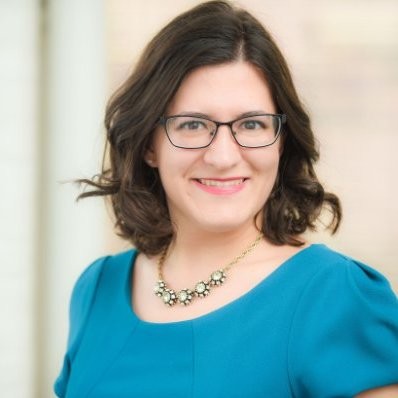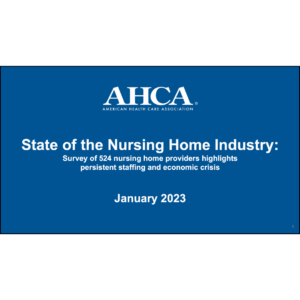2017 OPTIMA Award: Under one roof
It’s almost 6 p.m., and that means it’s time for Jerry to wheel over to the front desk, grab the remote and click on the flat-screen TV. Only today, Ebony Dukes catches him in the hallway first.
“I’ve been looking for you,” she says.
They have an intimate exchange filled with laughter and rapid-fire quips as she tells him about her day, which included a visit from family.
 |
| The intergenerational living program offers young adults an opportunity to learn more about the long-term care industry while giving them a place to live and work while going to college. Photo courtesy of Cindy Shain Photography. |
Dukes, 19, is a certified nursing assistant (CNA) at St. Joseph’s Rehabilitation & Residence in Portland, Maine. She also resides there as part of an intergenerational living program.
The 2017 OPTIMA award winner for Excellence in Resident-Focused Care found an innovative way to address its chronic staffing shortage now and encourage students to consider a career in long-term care in the future by opening its doors to college students.
The excitement in the hallways is hopefully a sign of things to come.
Growing gap
Healthcare is a booming industry fueled by baby boomers retiring, longer life expectancies and growing rates of chronic conditions.
And, as consumer demand increases, so does the need for skilled workers. Healthcare’s support occupations (23.2 percent) and healthcare practitioners and technical occupations (15.2 percent) will account for 14 of the 30 fastest-growing jobs and are projected to contribute about one-fifth of all new jobs by 2026, according to the Employment Projections: 2016-26 report from the Bureau of Labor Statistics.
“You can look at the national trends, and there’s some statistic that would say we don’t have enough young people going into aging services,” says Peggy Farrington, MPH, MHA, CDP, CADDCT, St. Joseph’s CEO and administrator. “The aging population is something that we’ve talked about for over a decade, but what are we actually doing about it?”
 |
| Many thanks to Omnicare, the program sponsor of the 2017 OPTIMA Award for Excellence in Resident-Focused Care. |
Skilled nursing providers are in dire need of new ideas for finding workers, particularly in Maine. The Maine Department of Labor’s Center for Workforce Research and Information (CWRI) estimates that between 2014 and 2024, nursing assistant employment will grow 9.2 percent. Total overall employment in Maine is expected to increase 0.8 percent.
The industry will continue to grow, with an expected 84 annual growth openings and 207 annual replacement openings. The CWRI 2015 job vacancy survey anticipates 921 job openings for nursing assistants, the fourth highest vacancy rate.
Compounding the staffing crisis is an aging workforce. The nation’s median age has increased nearly a decade since 1970. The impact is felt hardest in Maine, the oldest workforce in the nation. The median age of Maine workers is 44.5 years old, nearly seven years above the U.S. average, according to a Maine Workforce Outlook: 2014 to 2024 report from CWRI.
Furthermore, Maine’s seasonally adjusted unemployment rate was 3.7 percent in September 2017, lower than the national rate of 4.2 percent and reached a 40-year low earlier this spring.
In other words, it’s the mother of all silver tsunamis in Maine: Providers need to hire more workers to maintain census or grow, which the baby boomers will necessitate. Healthcare jobs are increasing in demand, and the pool of people to fill them is shrinking.
Costly problem
 |
| The intergenerational living program has primarily spread through word of mouth. Students recruited their friends, siblings and even boyfriend’s sibling. Photo by Nicole Stempak |
The growing need for healthcare workers is putting a strain on providers and employees while threatening residents’ quality of care. St. Joseph’s had a chronic staffing shortage, particularly for certified nursing assistants (CNAs).
They tried what everyone else was doing—sign-on bonuses, shift differentials, wage increases—but realized that wouldn’t solve their problem in the long run.
“We were really just stealing the CNA from a facility down the street,” Farrington says. “We’d pay 25 cents more. Then they would do it. They may be our competitors for the market, but they’re also our colleagues, and we’re all in need of CNAs.”
HR Director Jon Dahms says they post openings on their website and several online job boards local to Maine. They’ve tried radio ads and even direct mailing. But still, the vacancy rate consistently hovers around 25 full-time equivalent openings.
St. Joseph’s, like many other providers, relies on staffing agencies to fill the gap. But the turnover isn’t good for residents who benefit from consistent staffing. It’s also costly.
Temporary CNAs earn at least $25-28 an hour and RNs earn $43-47 an hour, plus shift differentials. That’s money St. Joseph’s must pay to maintain staffing levels that could otherwise be invested in staff, residents or the facility.
Farrington realized something needed to change, and they had to be the ones to do it. She followed the well-known Humanitas program in the Netherlands for years. It was finally the perfect time and opportunity to add college students to the mix.
Intentional living
Many intergenerational living programs have been small, temporary or ad hoc. Students may stay a semester or two as part of a one-time agreement. Or they may stay in exchange for periodic musical performances or spending time with residents.
These arrangements are made on an individual basis and are often the result of matching a student’s need for short-term housing with a provider’s spare rooms and are usually seen as an act of good will to the larger community.
Administrators at St. Joseph’s envisioned an intergenerational program as a way to solve its workforce shortage and reduce its growing use of agency staffing for CNAs.
They developed an intergenerational living program that requires students to live at St. Joseph’s and work a minimum of 16 hours per week. Students are asked to stay at least two semesters and can opt to stay during the summer, too. Students can work four-, eight- and 12-hour segments on all three shifts, and St. Joseph’s works with students to schedule shifts. Students can also sign up for additional hours and volunteer to be on call.
In exchange, students are offered free board, an attractive perk cited by students, many of whom did not have their own room at home and were commuting instead of living on campus because of costs. They are also paid for their work.
Students can work either as CNAs and earn $12 an hour or can serve as neighborhood assistants, a role specifically created for the program to help staff with nonmedical tasks, and earn $10.75 an hour. Both positions pay more than Portland’s minimum hourly wage and are eligible for shift differentials. St. Joseph’s also offers students the chance to become a CNA and will pay for course supplies, books and the exam fee.
Welcome aboard
St. Joseph’s does not have any formal relationships with area universities, so participating students can be any age, in any major and attend any university. They were, however, able to pitch the program to two nursing classes in the fall of 2016.
Interested students met with administrators, submitted an application and passed a background check, the same as any other employee. They completed the onboarding and training, which included the Virtual Dementia Tour training and discussion about what it means to work in long-term care. Prior to beginning the program, the majority of students never visited a long-term care facility, experienced death on a regular basis or known much about dementia.
Sonya Thibeau, director of admissions and dementia education, says the dementia training is an eye opener. “They’ll say, ‘Now I understand why so-and-so does this.’ It’s a lot of ‘aha’ moments after the training, which is great to see because it means they’re taking it seriously, and they want to learn.”
That gets to the heart of the program: exposing young people to the field of aging services. Farrington says she wants to show students this is a viable career choice. They are wanted, needed and can make a difference. She also hopes this program helps to change stereotypes about nursing homes and media portrayals about aging.
Because it deals with life and death, the intergenerational living program requires students to be wise beyond their years. It’s a tall order, but St. Joseph’s hasn’t yet had any problems finding interested students.
The first students started arriving in January 2017, and the program been growing ever since.
Making room
St. Joseph’s found itself in the unusual situation of having rooms to spare. The senior living provider sold its assisted living bed licenses a few years ago, and the wing has been empty ever since.
That’s where the students come in. Students live in Unit D all by themselves, which makes the hallway feel more like a student dorm than long-term care facility.
Maintenance has updated and modified the semiprivate rooms into private rooms with a shared toilet. Staff added door locks and offered students beds, desks and dressers—extras from the wing’s assisted living days.
There’s a shared shower stall and access to the employee bathroom across the facility. Maintenance Director Chuck Doustou says the shower situation hasn’t been an issue but acknowledges further modifications may be necessary if the program continues to grow.
They created common space, too. There’s a washer and dryer for students to use free of charge and a kitchenette with a coffee pot, crock pot, refrigerator and microwave. They even converted a bedroom into a lounge and filled it with an oversized brown sofa and recliner, coffee table, high-top table and chairs and flat-screen TV. Students added an Xbox gaming system.
There are restrictions that are taking some adjustment time. Administrators are trying to meet students’ desire to live independently while balancing safety concerns and federal regulations.
Students are offered a discounted rate for meals in the dining room, which administrators hoped would encourage students to eat with residents and compensate for the fact they don’t have access to a kitchen. That’s difficult for students, who may not be done with classes, are working or aren’t hungry when the facility’s dinner is served. So, they’ve come to a compromise: Students can order meals and have them set aside to eat later at their convenience.
It’s a start, and there’s likely going to be a need for more compromises in the future.
“The program is still pretty new, so we’re still kind of feeling it out,” Dukes says. “There’s a lot of potential, and we’re really optimistic.”
Farrington says they could have waited until the program was perfectly designed, but they decided to dive in and work out the wrinkles as they went. “I’m a believer that if we had waited until we had all the answers, which we still don’t have, we would have never started. You can’t possibly have all the answers to something like this. That’s not what it’s about. It was really more ‘let’s do this and figure it out as we go.’”
 |
| A student asks, then takes the hand of a resident with memory loss and walks him back to his room. Photo by Nicole Stempak |
Lasting impact
It was important to Farrington that this program grow through word of mouth. Students had to contact St. Joseph’s for more information, and it wasn’t until late August that St. Joseph’s put word about the program on its website. Farrington only finally agreed because staff were fielding so many inquiries.
Farrington doesn’t want the intergenerational program to become a marketing tool. She says any facility, even those right down the street, can start a similar program. She is solely focused on the workforce shortage and is trying to do something creative to solve it.
The intergenerational living program started as a way to reduce need for temporary agency staffing. It’s grown from two to 13 students and is already making a significant impact.
In five months, agency use of CNAs decreased about 43 percent, from 3,150 hours in January to 1,779 hours in May of 2017. St. Joseph’s saves about $12-14 an hour by paying workers directly and is making important gains in the second goal of changing the culture of aging.
One resident, Jerry, invited a student to watch football earlier in the year. The student showed up to watch the game off the clock. A long-time resident, Jerry told her he was surprised, that he didn’t think she would come. He said, “Just knowing that you live here makes me feel less lonely. You’re choosing to live here, and I have to live here.”
Those are the interactions Farrington hoped would result from an intergenerational living program. But, if they were going to happen, she says they had to happen organically. Those are the outcomes they desired—person-centered care, continuity of care, consistent assignments, reduced turnover, raised morale and increased resident, family and employee satisfaction—but couldn’t plan for.
“We can measure agency hours and cost savings, and we do need metrics and statistics,” Farrington says. “We can talk about measuring outcomes, but you can’t measure something like what Jerry said. That’s something Jerry felt and, in my opinion, was very remarkable in terms of doing something so small but so important.”
Many studies have touted the very real physical, mental and emotional benefits of seniors socializing and intergenerational interactions. Rachel Loubier, director of social services, is working to quantify the benefits of the intergenerational program for residents.
There are many evidence-based data to collect. For now, Loubier is focusing on the Patient Health Questionnaire (HPQ-9) and Brief Interview for Mental Status (BIMS) to measure resident depression, mood and level of activity participation.
There are a few residents who scored high with depression in the past. She’s already seen a decrease in their depression compared to three or four months ago but says it may take a full year to get the complete picture. She says students are helping strapped staff engage and provide one-on-one attention with residents either in their rooms or in a group setting. Those interactions are increasing participation and reducing isolation, which should further reduce depression.
The program also has anecdotal evidence for benefitting students, too.
“You make meaningful connections with these people,” Dukes says. “You get to talking, and you talk with their husbands or their wives. You learn about them and their lives, and they learn about you. It’s one of my favorite parts of the job.
“I think, honestly, it’s more beneficial for us as students because we get to learn from them. We have nurses, doctors, police officers and all these incredible people living here. They have so much to tell you and so much you can learn. I feel like working here and getting to know people is making me more compassionate and understanding.”

Nicole was Senior Editor at I Advance Senior Care and Long Term Living Magazine 2015-2017. She has a Journalism degree from Kent State University and is finalizing a master’s degree in Information Architecture and Management. She has extensive studies in the digital user experience and in branding online media. She has worked as an editor and writer for various B2B publications, including Business Finance.
Related Articles
Topics: Articles , Executive Leadership , Facility management , Leadership , Staffing , Training










